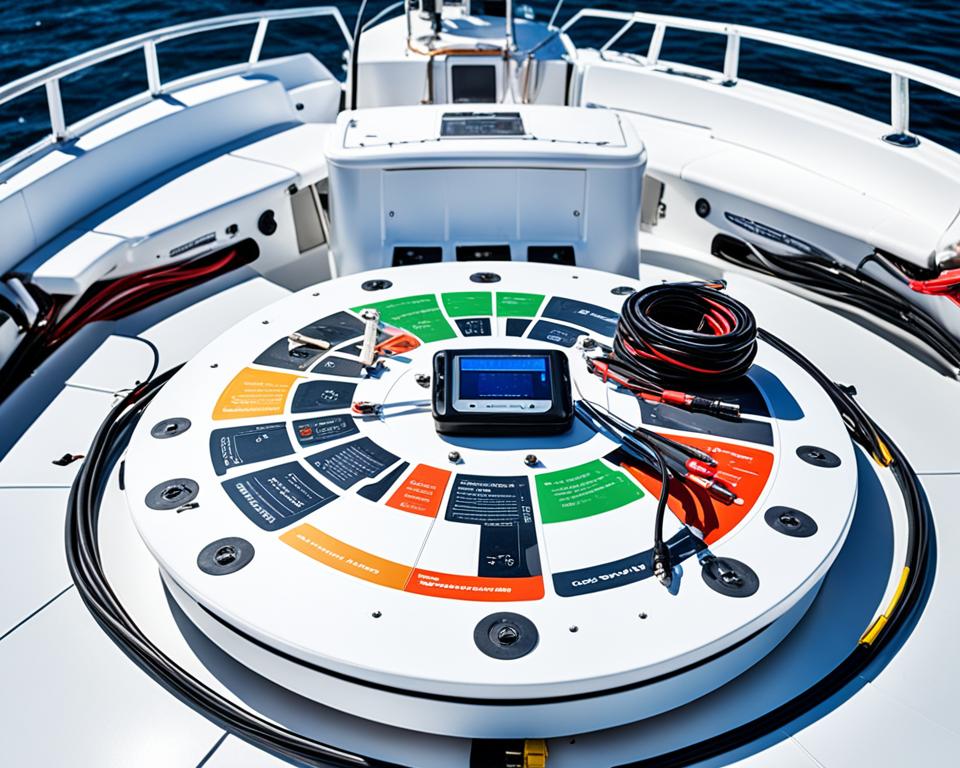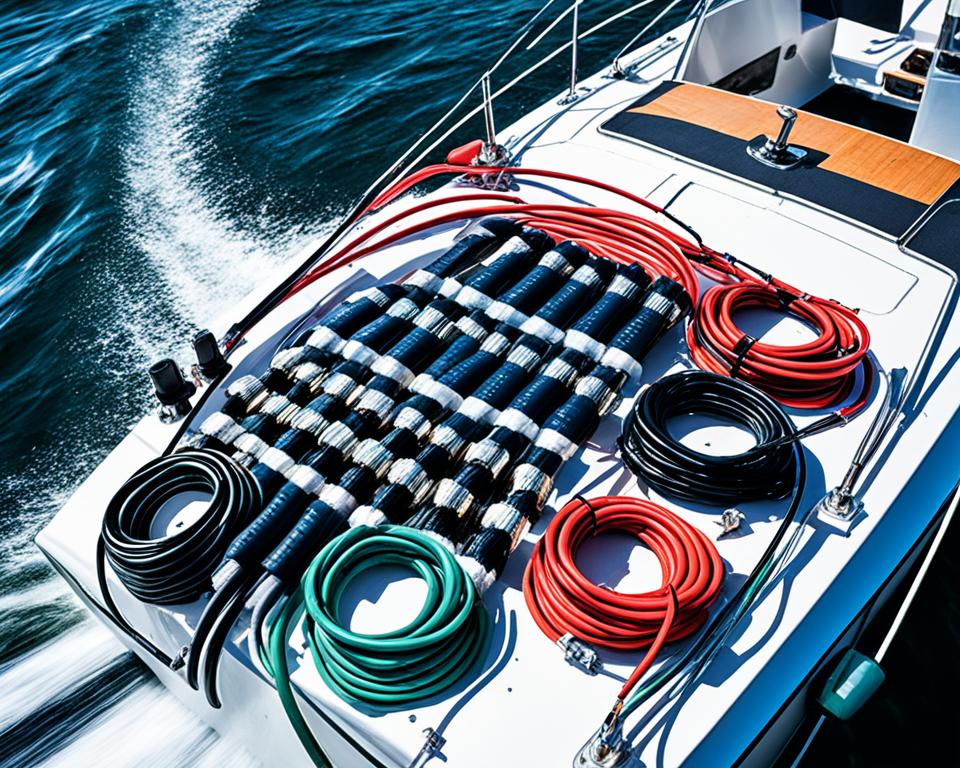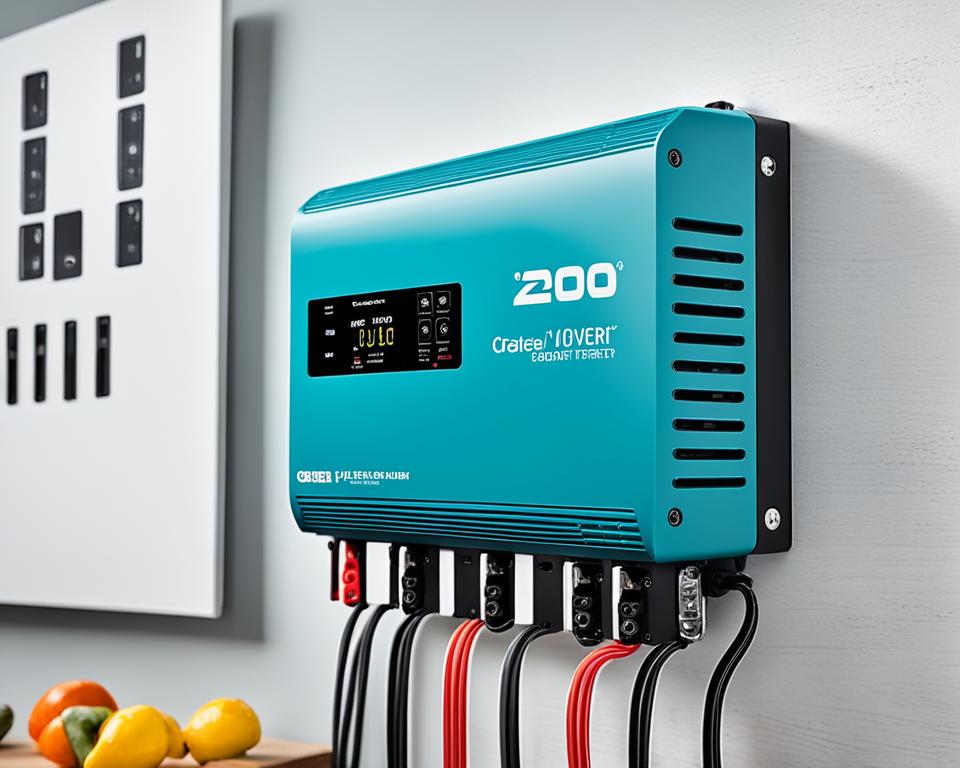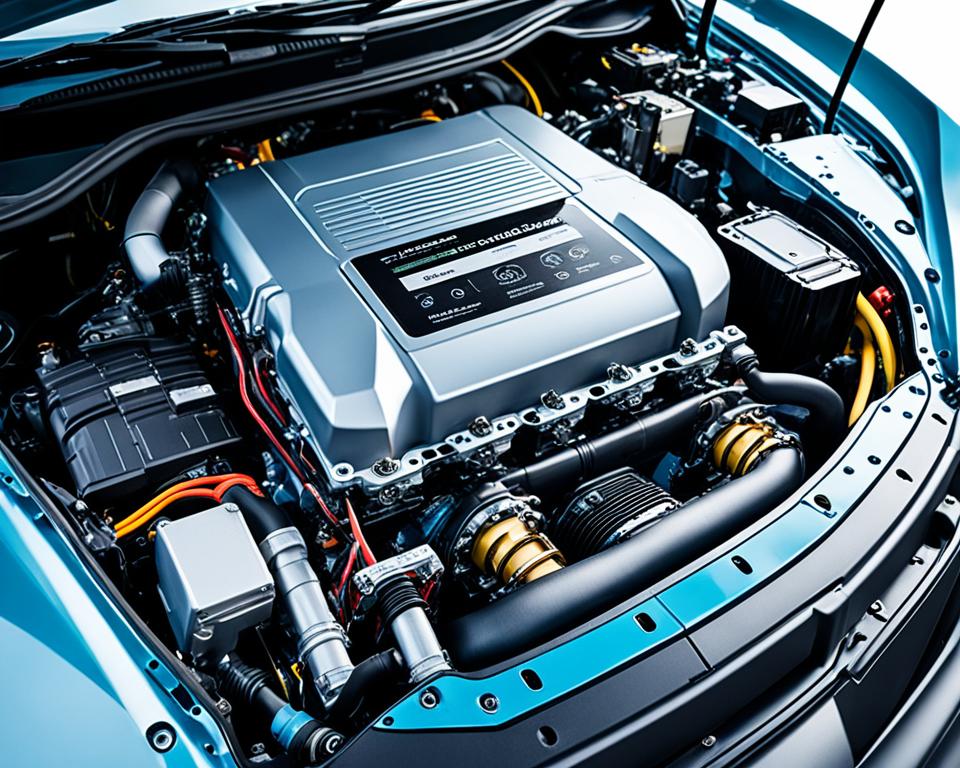A deep cycle marine battery is key for powering your boat. It’s different from regular batteries because it gives steady, long power for things like lights, pumps, and entertainment. These batteries are tough and work well even in tough conditions.
Read interesting things at : climbing-gym-oz
Key Takeaways
- Deep cycle marine batteries give steady, long power for your boat’s systems.
- They can handle the tough marine environment and work reliably.
- Choosing the right deep cycle marine battery is key for your boat’s smooth running.
- Setting up, installing, and maintaining your marine battery bank is important for best performance and life.
- New battery tech, like AGM and lithium-ion, brings new solutions for boats.
This guide will cover deep cycle marine batteries and their special design. We’ll talk about their benefits and how to pick the best one for your boat. We’ll also look at setting up a marine battery bank, installation, and maintenance. Plus, we’ll explore the latest tech that changes how we power our boats.
What is a Deep Cycle Marine Battery?
A deep cycle marine battery is key to a reliable boat electrical system. They are different from starting batteries because they give steady power for a long time. These batteries are great for powering things like boat accessories, trolling motors, and important electronics.
Understanding the Unique Design
Deep cycle marine batteries stand out because of their special design. They have thicker lead plates and a strong internal structure. This lets them handle being fully discharged and recharged many times without losing power. They last longer than starting batteries, making them a smart choice for boat owners.
Advantages Over Starting Batteries
- Sustained power delivery for extended periods
- Ability to withstand regular deep discharges without damage
- Longer overall lifespan, typically 3-5 years with proper maintenance
- Suitability for powering onboard accessories and electronics
- Compatibility with various charging systems and boat electrical configurations
Knowing the benefits of deep cycle marine batteries helps you make the right choice. It ensures your boat’s electrical system meets the marine environment’s needs.
“Deep cycle marine batteries are the unsung heroes of the boating world, providing the reliable power that keeps our adventures afloat.”
Choosing the Right Deep Cycle Marine Battery
Finding the right deep cycle marine battery is key for reliable power and top performance. Not all batteries are the same. You need to think about the battery’s capacity, voltage, size, and if it fits your boat’s electrical setup.
First, figure out your power needs. Is your boat small for fishing or is it a big yacht? The size and power needs of your boat will tell you the battery capacity you need. A bigger capacity (in amp-hours) means the battery lasts longer between charges.
| Battery Capacity | Boat Size |
|---|---|
| 80-100 Ah | Small fishing boat |
| 150-200 Ah | Medium-sized boat |
| 300+ Ah | Large yacht |
Then, look at the voltage. Most marine batteries are 12V or 6V. 12V batteries are common, but you can link 6V batteries together for more power.
Size matters too. Make sure the marine battery fits in your boat’s space. Check the space before buying to avoid any issues.
Lastly, check if the marine battery works with your boat’s electrical setup. This means looking at the terminal placement and post size. A marine electronics expert can help you choose the right one.
By thinking about these factors, you can pick the best deep cycle marine battery for your boat. This ensures your boat’s accessories, electronics, and important systems work well. It makes sailing smooth and reliable.
Battery Bank Setup for Boats
Building a reliable marine battery bank is key for your boat’s electrical systems. You must decide between parallel or series connections. Each option has its pros and cons, depending on your boat and needs.
Parallel vs. Series Configurations
In a parallel setup, several marine battery units link their positive and negative ends. This boosts capacity, adding up the Ah ratings of each battery. It also means if one battery fails, the others keep working. But, all batteries must be the same type and age for balanced charging and discharging.
Series connections link a battery’s positive to the next negative, creating a chain. This raises the voltage, great for high-voltage needs like inverters. But, a single battery failure can take down the whole bank. So, using the right marine battery cables and connections is crucial.
| Parallel Configuration | Series Configuration |
|---|---|
| Increased capacity (total Ah) | Higher overall voltage |
| Redundancy (one battery failure doesn’t affect others) | Less forgiving (one battery failure impacts the whole bank) |
| Requires matching batteries | Requires proper cabling and connections |
When setting up your marine battery bank, think about your power needs, space, and the pros and cons of parallel and series. This will help you choose the best option for your boat.
Marine Battery Bank Sizing
Powering your boat depends a lot on the marine battery bank. It’s key to pick the right size for your boat battery bank. This ensures it meets your boat’s power needs.
To figure out the total amp-hours needed, think about your boat’s electrical load and how you use it. This will help you choose the right number and capacity of deep cycle batteries for your boat.
Calculating Your Power Needs
First, list all the electrical devices on your boat, like navigation systems and lights. Then, guess how much power each uses, in amperes (A) or watts (W).
Next, think about how long you’re usually out on the water. This helps you figure out the total amp-hours (Ah) you’ll need. A good rule is to have a battery bank that can give at least 1.5 times the total amp-hours needed. This ensures you have enough power in reserve.
| Device | Power Consumption (A) | Usage Duration (hours) | Total Amp-Hours Needed |
|---|---|---|---|
| Navigation system | 5 | 8 | 40 |
| Cabin lights | 3 | 6 | 18 |
| Bilge pump | 1 | 4 | 4 |
| Total Amp-Hours Needed | 62 | ||
| Recommended Battery Bank Size (1.5x) | 93 Ah |
By carefully figuring out your power needs and picking the right marine battery bank size, you make sure your boat has enough power. This lets you run all your important electronics and accessories smoothly. It makes your boating time more fun and dependable.
Deep Cycle Marine Battery Installation and Maintenance
Installing and maintaining your deep cycle marine batteries right is key to their long life and good performance. Make sure to mount them securely and keep them well-ventilated. This helps your boat batteries last longer.
Proper Mounting and Ventilation
When putting in your deep cycle marine battery, make sure it’s in a marine battery box or a good spot. This keeps it safe from shaking, bumps, and harm. Also, keep it in a spot with good airflow. This is because these batteries can make hydrogen gas while charging, which is dangerous if not let out safely.
- Use a strong, rust-proof battery tray or box made for the sea.
- Make sure the battery is tied down well so it doesn’t move around in bad weather.
- Give the battery enough room to breathe to keep it well-ventilated.
- Don’t put the battery in a tight spot without enough air.
It’s also key to keep the battery terminals and connections clean. Check them often for rust and clean them when needed. This keeps the electrical link strong and dependable.
| Mounting Considerations | Ventilation Requirements |
|---|---|
| Use a marine-grade battery tray or box | Ensure adequate airflow around the battery |
| Secure the battery firmly in place | Avoid enclosed spaces without ventilation |
| Prevent battery from shifting or moving | Allow for proper hydrogen gas dispersion |
By doing these things for installation and upkeep, you can make sure your deep cycle marine batteries work well and last a long time for your boat.
Charging Your Deep Cycle Marine Batteries
Keeping your deep cycle marine batteries charged is key for reliable power and a long battery life. It’s important to use the right boat battery charger and methods. This helps avoid overcharging and keeps the charging voltage and current right.
Here are some tips to keep your deep cycle marine batteries ready to go:
- Pick a boat battery charger made for marine batteries. These chargers meet the special needs of deep cycle batteries.
- Watch the charging closely. Don’t overcharge, as it can harm the batteries and shorten their life.
- Keep the charging voltage and current right. Use your battery maker’s advice to set the correct settings.
- Check the battery’s water levels often and add distilled water as needed, especially for flooded lead-acid marine batteries.
- Think about getting a smart boat battery charger with features like automatic voltage control and temperature adjustment for the best charging.
By doing these things, you’ll keep your deep cycle marine batteries in great shape. This means you’ll have reliable power for all your boating trips.
| Feature | Benefit |
|---|---|
| Optimized for deep cycle marine batteries | Ensures proper charging and maximizes battery life |
| Automatic voltage regulation | Keeps the charging voltage right to stop overcharging |
| Temperature compensation | Changes charging settings based on the temperature for the best results |
| Multistage charging | Gives a full charge for the most battery capacity and longest life |
Choosing the right boat battery charger and charging correctly will keep your deep cycle marine batteries in top shape. This way, you’ll have reliable power for all your boating fun.

“Proper charging is the key to maintaining the health and performance of your deep cycle marine batteries.”
Marine Battery Chargers and Inverters
Keeping your deep cycle marine batteries in good shape is key. It’s important to pick the right boat battery charger. This ensures your batteries work well and give you the power you need for your boat.
Choosing the Right Charger
When looking at marine battery chargers, there are a few things to think about. The kind of deep cycle marine battery you have, the size of your battery bank, and what the charger can do are all important. Let’s look at what to consider:
- Battery type: Chargers work best with certain battery chemistries, like lead-acid, AGM, or lithium-ion. Make sure the charger fits your battery type.
- Charging rate: The charger’s amperage should match what your battery bank needs. Picking a charger with the right capacity keeps your batteries healthy and extends their life.
- Charging stages: Choose chargers with stages like bulk, absorption, and float. This ensures your batteries charge fully and evenly.
- Voltage output: The charger’s voltage must fit your battery bank’s setup (like 12V, 24V, or 48V).
- Durability and weatherproofing: Since marine environments are tough, pick a charger that’s strong and can handle the weather.
| Feature | Recommended Specification |
|---|---|
| Battery Type | Lead-Acid, AGM, or Lithium-Ion |
| Charging Rate | 10-20% of the battery’s Ah capacity |
| Charging Stages | Bulk, Absorption, and Float |
| Voltage Output | Matching your battery bank configuration |
| Weatherproofing | Suitable for marine environments |
By thinking about these things, you can find the perfect boat battery charger for your deep cycle marine battery. This keeps your system healthy and ready for your water adventures.
Golf Cart Batteries for Boats
Have you thought about using golf cart batteries for your boat? They might seem like an unusual choice, but they can be a budget-friendly option. Golf cart batteries and deep cycle marine batteries have some things in common. But, it’s important to know the pros and cons of using golf cart batteries on your boat.
Golf cart batteries are built to handle deep discharges well, just like deep cycle marine batteries. This makes them a good choice for boat owners wanting to cut down on battery costs. But, they’re not made for the tough marine environment. This can affect how well they work and how long they last.
| Comparison | Golf Cart Batteries | Deep Cycle Marine Batteries |
|---|---|---|
| Design | Optimized for golf carts, not marine environments | Specially designed for marine applications, with corrosion-resistant components |
| Vibration Resistance | May not be as durable as marine-specific batteries | Engineered to withstand the vibrations and shocks of boat usage |
| Capacity | Typically range from 6V to 12V, with varying amp-hour ratings | Offer a wide range of capacities to suit different boat power needs |
| Lifespan | Shorter lifespan compared to deep cycle marine batteries | Designed for longer lifespan and more cycles |
Before picking golf cart batteries for your boat, think about your power needs, the marine setting, and what you expect from your batteries. Golf cart batteries can be a budget-friendly choice. But, deep cycle marine batteries might be a better fit for your boat’s power needs because they last longer and perform better.
AGM vs. Flooded Lead-Acid Marine Batteries
Choosing between AGM (Absorbent Glass Mat) and flooded lead-acid deep cycle marine batteries is key for your boat. Each type has its pros and cons. Knowing these differences helps you pick the right one for your boat’s power needs and how you use it.
AGM Marine Batteries: Convenience and Reliability
AGM marine batteries use a special absorbent glass mat. This keeps the electrolyte inside the battery without being liquid. This design brings many benefits:
- Spill-proof and maintenance-free operation
- Increased resistance to vibration and shock
- Faster charging and discharging capabilities
- Longer lifespan compared to traditional flooded batteries
Flooded Lead-Acid Marine Batteries: Cost-Effective Power
Flooded lead-acid marine batteries are a budget-friendly choice for boat owners. They need regular checks and charging but are reliable and affordable. The main benefits of these batteries are:
- Lower initial cost
- Higher energy density for longer runtime
- Easier to repair and replace individual cells
Choosing between AGM and flooded lead-acid marine batteries depends on your needs, budget, and how you use your boat. Think about maintenance, power needs, and battery life to pick the best one for your boat.
Lithium Marine Batteries: Pros and Cons
The marine world is changing, and lithium-ion batteries are becoming a top choice for boat owners. These batteries are light and pack a lot of power. They’re great for keeping your boat’s systems running smoothly.
Advantages of Lithium Marine Batteries
- Higher energy density: Lithium-ion batteries store more energy in less space, giving you more power for your boat’s gadgets and appliances.
- Faster charging: You can recharge lithium batteries quickly, which means less waiting and more time on the water.
- Longer lifespan: With the right care, lithium marine batteries can last for many years, longer than traditional batteries.
Considerations for Lithium Marine Batteries
Lithium-ion batteries have many benefits, but there are things to think about when using them on your boat:
- Cost: These batteries cost more upfront than lead-acid ones, which might be a challenge for some boat owners.
- Battery management: Lithium batteries need special systems to work safely and efficiently, adding to the complexity.
- Temperature sensitivity: Lithium-ion batteries don’t like extreme temperatures, which can affect how well they work and how long they last.
Choosing between lithium marine batteries and deep cycle marine batteries depends on what you need, your budget, and what you prefer. Think about the pros and cons to pick the best option for your boat. This will help keep your boat battery in top shape and make your boating trips enjoyable.
| Feature | Lithium Marine Batteries | Lead-Acid Marine Batteries |
|---|---|---|
| Energy Density | High | Low |
| Charging Time | Fast | Slow |
| Lifespan | Longer | Shorter |
| Cost | Higher | Lower |
| Temperature Sensitivity | More Sensitive | Less Sensitive |
Trolling Motor Batteries
Trolling motors are key for serious anglers. They offer quiet, precise control for moving through the water and setting up for the best cast. But, they need a special power source – the trolling motor battery. These batteries are deep cycle marine batteries, made to give long-lasting power for fishing trips.
Maximizing Trolling Motor Battery Performance
Choosing the right trolling motor battery is crucial. Look at capacity, voltage, and size. A battery with more amp-hours (Ah) lasts longer between charges. Also, a 12-volt battery fits most boats and motors.
Here are tips to get the best from your trolling motor batteries:
- Size your battery bank to match your motor’s power needs
- Mount batteries securely and keep them well-ventilated to avoid overheating
- Follow the maker’s advice for regular maintenance and charging
- Use a top-quality boat battery charger to keep batteries in top shape
By doing these things, you can make your trolling motor batteries last longer and perform better. This means more time fishing and less time worrying about your power.
The right deep cycle marine battery is key for a great fishing trip. With good care and upkeep, your trolling motor batteries will give you the reliable power you need. This lets you stay on the water, chasing your next big catch.
Marine Battery Cables and Connections
Choosing the right marine battery cables is key for your boat’s safe and efficient use. The right gauge and type of cables greatly affect your battery’s performance and life.
Think about your boat’s size and power needs when picking cables. Picking cables that are too small can lead to voltage drops and safety issues. But, choosing cables that are too big is a waste of money. A marine electronics expert can help find the perfect size for you.
Maintaining Secure Connections
Connections are as important as the cables. Bad connections can cause power loss and safety risks. Here’s how to keep your connections safe:
- Use marine-grade terminal connectors made for boat batteries
- Clean terminals and connectors often to stop corrosion
- Apply a protectant to connections to prevent corrosion
- Tighten connections well, but don’t overdo it to avoid damage
Choosing the right marine battery cables and keeping connections tight and corrosion-free is key. This ensures your deep cycle marine battery system works well and safely. It gives you the power you need for your boat battery needs.

| Cable Gauge | Recommended for | Advantages |
|---|---|---|
| 4 AWG | Small boats, trolling motors | Lightweight, flexible, and easy to work with |
| 2 AWG | Larger boats, higher power needs | Improved conductivity, better voltage retention |
| 0 AWG | Heavy-duty applications, high-output systems | Maximum conductivity, ideal for long cable runs |
Marine Battery Boxes and Enclosures
Keeping your deep cycle marine batteries safe is key for their long life and your safety. A good marine battery box protects your boat battery investment. It also keeps the power flowing smoothly for your boat.
There are many marine battery boxes to pick from. Some let air in to prevent dangerous gas buildup. Others are water-resistant to keep out the elements. Some even come with handles or wheels for easy moving and setting up.
When choosing a marine battery box, think about your deep cycle marine batteries size and how many you have. Consider the space you have on your boat and how much protection you need. Make sure the box is securely fastened and your boat battery connections are safe and dry.
- Vented design for gas evacuation
- Water-resistant construction for marine environments
- Sturdy construction to withstand the rigors of boating
- Adequate size to accommodate your deep cycle marine battery needs
- Easy-to-use features like handles or wheels for transport
Choosing the right marine battery box for your deep cycle marine batteries helps them last longer. It ensures reliable power and keeps your boat and everyone on it safe. Storing and protecting your batteries is a big part of being a responsible boat owner.
Battery Monitoring Systems for Boats
For marine enthusiasts, keeping your deep cycle marine batteries in top shape is key to a great boating experience. A battery monitoring system is a great tool for this. It gives you real-time info on your boat batteries, helping you make smart choices and extend their life.
These systems let you track important things like battery voltage, current, and charge level. This info helps you keep an eye on how your marine batteries are doing. It prevents the bad situation of being stuck with a dead battery on the water.
- Real-time battery voltage and current monitoring
- Tracking of battery state of charge and capacity
- Alerts for potential issues or imbalances in your battery bank
- Historical data logging for long-term performance analysis
Adding a battery monitoring system to your boat can change the game. It gives you useful info and helps you decide when to charge, maintain, or replace your deep cycle marine batteries. Keeping an eye on your battery health means your boat will always be ready for your next trip.
| Feature | Benefit |
|---|---|
| Real-time Monitoring | Stay informed about your battery levels and prevent unexpected power issues |
| Predictive Maintenance | Anticipate when your marine batteries will need replacement or servicing |
| Customizable Alerts | Receive notifications when your batteries are low or require attention |
| Data Logging | Track long-term battery performance and optimize your power management |
Investing in a good battery monitoring system is a smart move for your deep cycle marine batteries. This tool makes managing your boat’s power better. It keeps you confident and ready for any adventure on the water.
Conclusion
In this guide, we’ve looked into deep cycle marine batteries and their special design. We’ve seen how they’re different from regular starting batteries. We’ve also covered how to pick the right battery for your boat and set up a reliable battery bank.
For both seasoned boaters and newcomers, this article aims to help you make smart choices about your deep cycle marine battery system. By learning about battery setup, charging, and upkeep, you can make your power source last longer and improve your boat’s performance.
When you’re out on the water, remember that a well-chosen and well-maintained deep cycle marine battery is key to your boat’s electrical system. This guide has given you the tools to keep your vessel powered and ready for adventure. With these tips, you can explore new places and make unforgettable memories on the sea.



